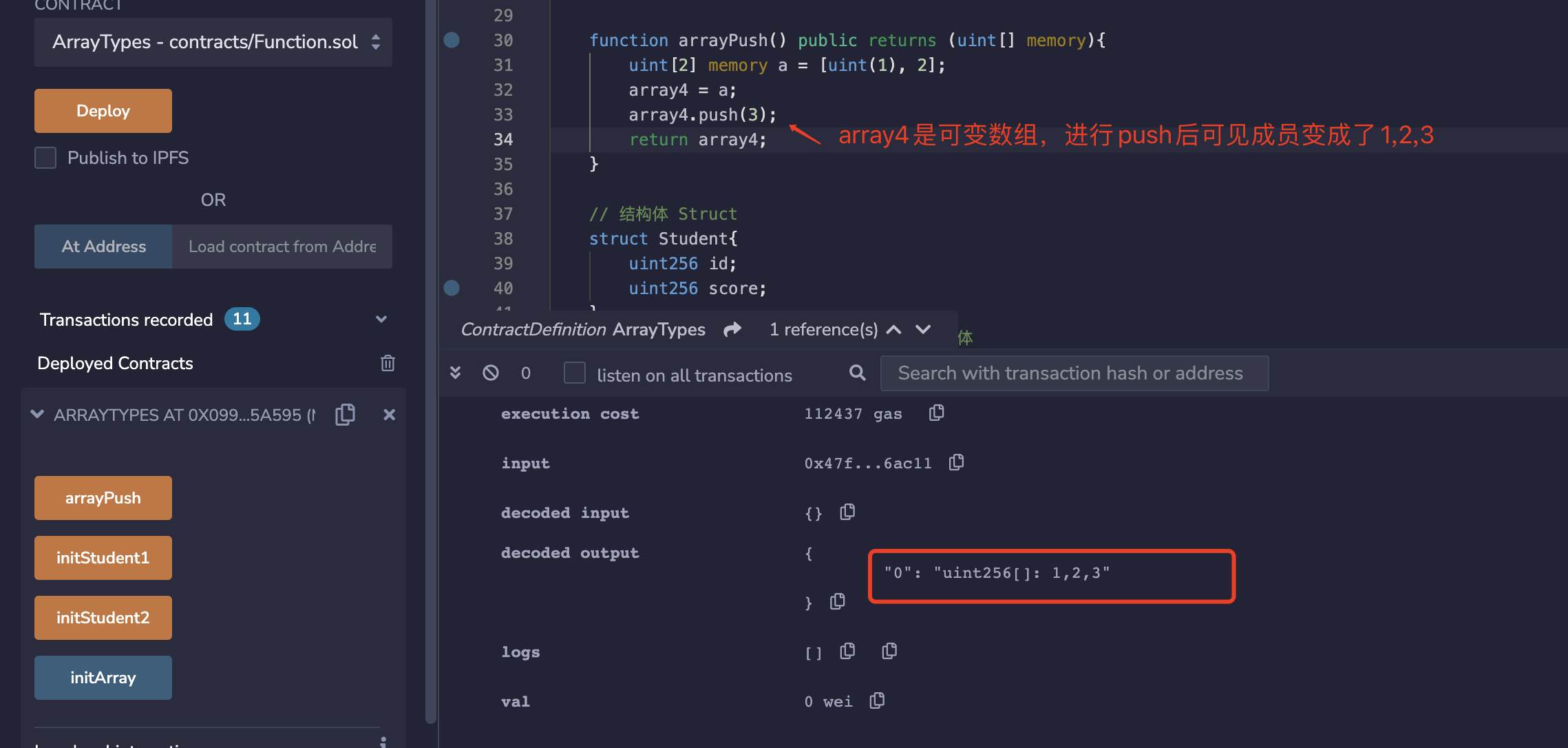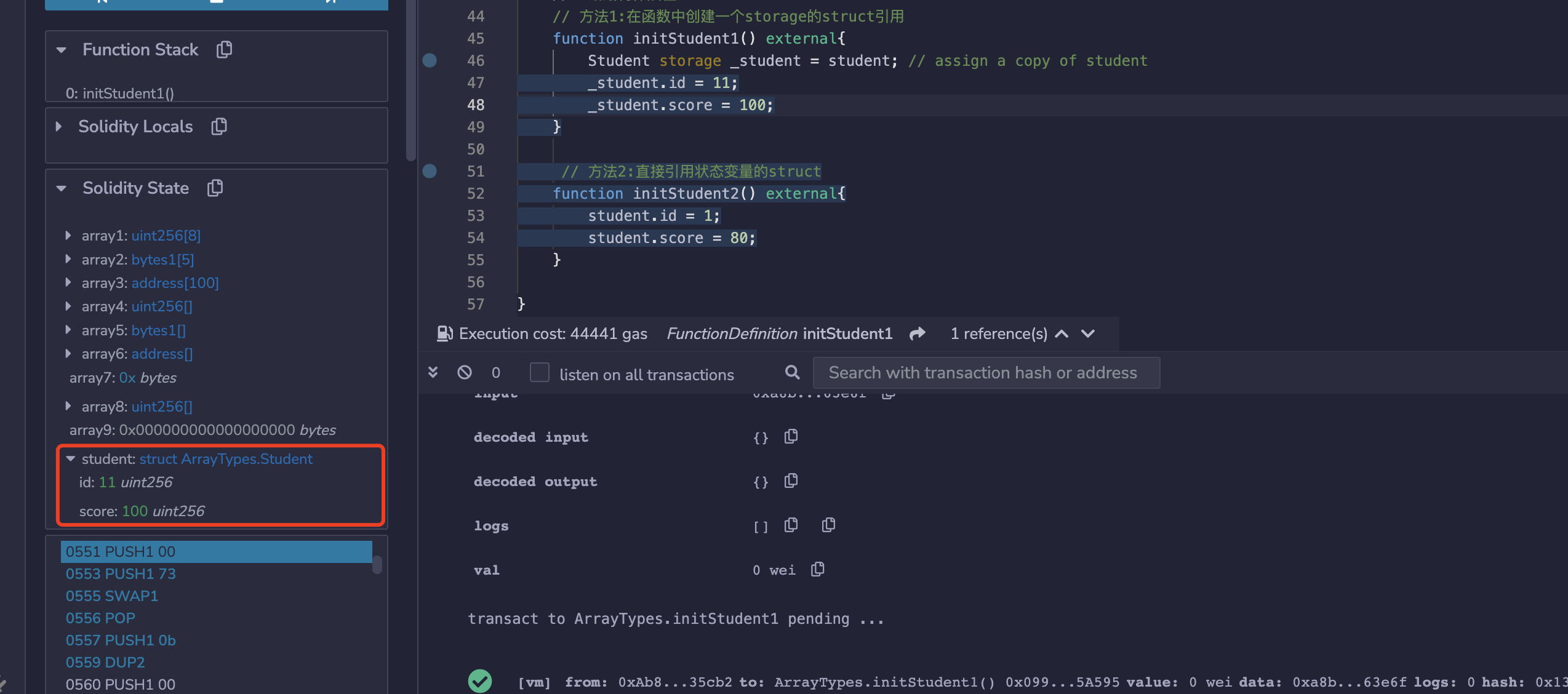# Solidity极简入门: 6. 引用类型, array, struct
我最近在重新学solidity,巩固一下细节,也写一个“Solidity极简入门”,供小白们使用(编程大佬可以另找教程),每周更新1-3讲。
欢迎关注我的推特:@0xAA_Science (opens new window)
所有代码开源在github(64个star开微信交流群,已开填表加入 (opens new window);128个star录教学视频): github.com/AmazingAng/WTFSolidity (opens new window)
这一讲,我们将介绍solidity中的两个重要变量类型:数组(array)和结构体(struct)。
# 数组 array
数组(Array)是solidity常用的一种变量类型,用来存储一组数据(整数,字节,地址等等)。数组分为固定长度数组和可变长度数组两种:
- 固定长度数组:在声明时指定数组的长度。用
T[k]的格式声明,其中T是元素的类型,k是长度,例如:
// 固定长度 Array
uint[8] array1;
byte[5] array2;
address[100] array3;
- 可变长度数组(动态数组):在声明时不指定数组的长度。用
T[]的格式声明,其中T是元素的类型,例如(bytes比较特殊,是数组,但是不用加[]):
// 可变长度 Array
uint[] array4;
byte[] array5;
address[] array6;
bytes array7;
# 创建数组的规则
在solidity里,创建数组有一些规则:
- 对于
memory修饰的动态数组,可以用new操作符来创建,但是必须声明长度,并且声明后长度不能改变。例子:
// memory动态数组
uint[] memory array8 = new uint[](5);
bytes memory array9 = new bytes(9);
- 数组字面常数是写作表达式形式的数组,并且不会立即赋值给变量,例如
[uint(1),2,3](需要声明第一个元素的类型,不然默认用存储空间最小的类型) - 如果创建的是动态数组,你需要一个一个元素的赋值。
uint[] memory x = new uint[](3);
x[0] = 1;
x[1] = 3;
x[2] = 4;
# 数组成员
length: 数组有一个包含元素数量的length成员,memory数组的长度在创建后是固定的。push():动态数组和bytes拥有push()成员,可以在数组最后添加一个0元素。push(x):动态数组和bytes拥有push(x)成员,可以在数组最后添加一个x元素。pop():动态数组和bytes拥有pop()成员,可以移除数组最后一个元素。
Example: 
# 结构体 struct
Solidity支持通过构造结构体的形式定义新的类型。创建结构体的方法:
// 结构体
struct Student{
uint256 id;
uint256 score;
}
Student student; // 初始一个student结构体
给结构体赋值的两种方法:
// 给结构体赋值
// 方法1:在函数中创建一个storage的struct引用
function initStudent1() external{
Student storage _student = student; // assign a copy of student
_student.id = 11;
_student.score = 100;
}
Example: 
// 方法2:直接引用状态变量的struct
function initStudent2() external{
student.id = 1;
student.score = 80;
}
Example: 
# 总结
这一讲,我们介绍了solidity中数组(array)和结构体(struct)的基本用法。下一讲我们将介绍solidity中的哈希表——映射(mapping)。
← 5. 变量数据存储和作用域 7. 映射类型 →